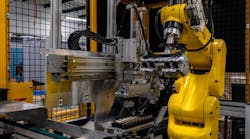Described in ASTM F 735, the Model 6100 oscillating sand tester is used to measure the resistance of a material to surface abrasion and scratching. It’s primary application is for transparent materials and coatings utilized in windows and lenses, but it can also be used to evaluate organic coatings, plastics, metals and other materials. Specimens are mounted in a holder located in the bottom of a “sand cradle” (sand tray) so that surfaces are flush within 1mm. The tray is filled to a uniform depth with a standardized abrasive media such as quartz silica or alumina. A scotch-yoke drive system reciprocates the tray in a back-and-forth (to-and-fro) motion which causes the entire mass of the abrasive media to shift significantly within the tray. The abrasive media typically results in a random pattern of scratches which simulates normal everyday wear. In addition to the dry abrasion test, the oscillating abrasion (sand) tester may be used with an abrasive slurry to perform erosion tests. An optional kit is also available to conduct the ‘Bayer test’ on contoured lenses. This set-up involves testing a specimen against a control lens for comparative purposes. Test parameters can be altered with Taber’s Oscillating Abrasion (Sand) Tester, and allow the operator to select the operating stroke length (1, 2, 3, or 4 inches) and speed (variable from 100 - 200 cycles per minute). In addition, there are numerous types of abradants that could be used with this instrument: including quartz silica, aluminum oxide, silicon carbide, glass beads, plus others.





